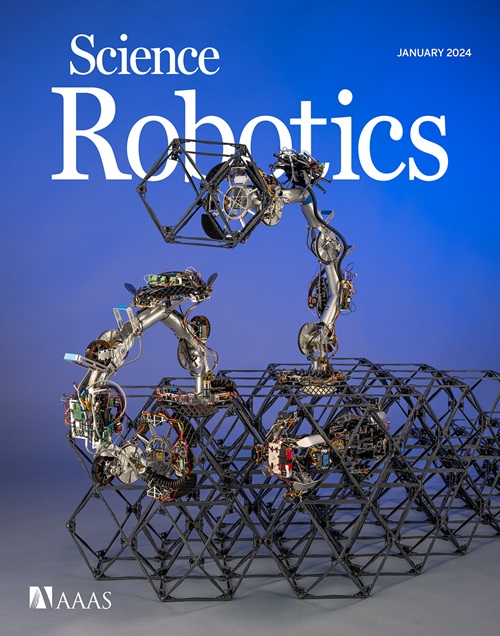Reversible kink instability drives ultrafast jumping in nematodes and soft robots
IF 27.5
1区 计算机科学
Q1 ROBOTICS
引用次数: 0
Abstract
Entomopathogenic nematodes (EPNs) exhibit a bending-elastic instability, or kink, before becoming airborne, a feature previously hypothesized but not substantiated to enhance jumping performance. Here, we provide the evidence that this kink is crucial for improving launch performance. We demonstrate that EPNs actively modulate their aspect ratio, forming a liquid-latched α-shaped loop over a slow timescale (1 second), and then rapidly open it (10 microseconds), achieving heights of 20 body lengths and generating power of ∼104 watts per kilogram. Using a bioinspired physical model [termed the soft jumping model (SoftJM)], we explored the mechanisms and implications of this kink. EPNs control their takeoff direction by adjusting their head position and center of mass, a mechanism verified through phase maps of jump directions in numerical simulations and SoftJM experiments. Our findings reveal that the reversible kink instability at the point of highest curvature on the ventral side enhances energy storage using the nematode’s limited muscular force. We investigated the effect of the aspect ratio on kink instability and jumping performance using SoftJM and quantified EPN cuticle stiffness with atomic force microscopy measurements, comparing these findings with those of Caenorhabditis elegans. This investigation led to a stiffness-modified SoftJM design with a carbon fiber backbone, achieving jumps of ∼25 body lengths. Our study reveals how harnessing kink instabilities, a typical failure mode, enables bidirectional jumping in soft robots on complex substrates like sand, offering an approach for designing limbless robots for controlled jumping, locomotion, and even planetary exploration.
可逆扭结不稳定性驱动线虫和软机器人超快跳跃
昆虫病原线虫(epn)在成为空气之前表现出弯曲弹性不稳定性或扭结,这是先前假设的特征,但没有证实可以增强跳跃性能。在这里,我们提供的证据表明,这种扭结是提高发射性能的关键。我们证明epn主动调节其长径比,在慢时间尺度O(1秒)上形成一个液体锁住的α形环路,然后快速打开O(10微秒),达到20个身长的高度,产生每公斤104瓦的功率。使用生物启发的物理模型[称为软跳跃模型(SoftJM)],我们探索了这种扭结的机制和含义。epn通过调整头部位置和质心来控制自己的起飞方向,这一机制在数值模拟和SoftJM实验中得到了验证。我们的研究结果表明,在腹侧最高曲率处的可逆扭结不稳定性利用线虫有限的肌肉力增强了能量储存。我们使用SoftJM软件和原子力显微镜测量量化EPN角质层刚度,研究了纵横比对扭结不稳定性和跳跃性能的影响,并将这些结果与秀丽隐杆线虫的结果进行了比较。这项研究导致了一种带有碳纤维骨架的刚度改进SoftJM设计,实现了~ 25个身体长度的跳跃。我们的研究揭示了如何利用扭结不稳定性(一种典型的失效模式)使软机器人能够在复杂的基质(如沙子)上双向跳跃,为设计无肢机器人进行受控跳跃、运动甚至行星探索提供了一种方法。
本文章由计算机程序翻译,如有差异,请以英文原文为准。
求助全文
约1分钟内获得全文
求助全文
来源期刊

Science Robotics
Mathematics-Control and Optimization
CiteScore
30.60
自引率
2.80%
发文量
83
期刊介绍:
Science Robotics publishes original, peer-reviewed, science- or engineering-based research articles that advance the field of robotics. The journal also features editor-commissioned Reviews. An international team of academic editors holds Science Robotics articles to the same high-quality standard that is the hallmark of the Science family of journals.
Sub-topics include: actuators, advanced materials, artificial Intelligence, autonomous vehicles, bio-inspired design, exoskeletons, fabrication, field robotics, human-robot interaction, humanoids, industrial robotics, kinematics, machine learning, material science, medical technology, motion planning and control, micro- and nano-robotics, multi-robot control, sensors, service robotics, social and ethical issues, soft robotics, and space, planetary and undersea exploration.
 求助内容:
求助内容: 应助结果提醒方式:
应助结果提醒方式:


